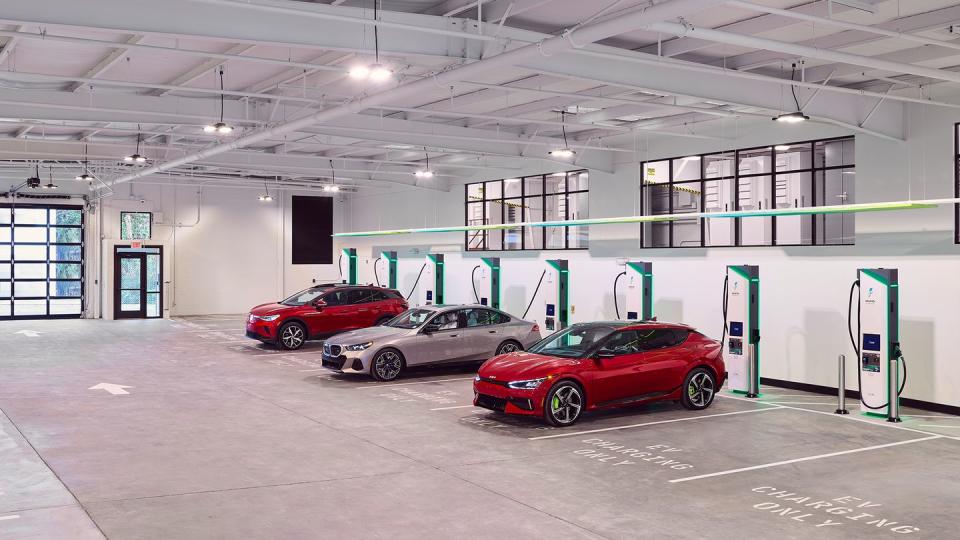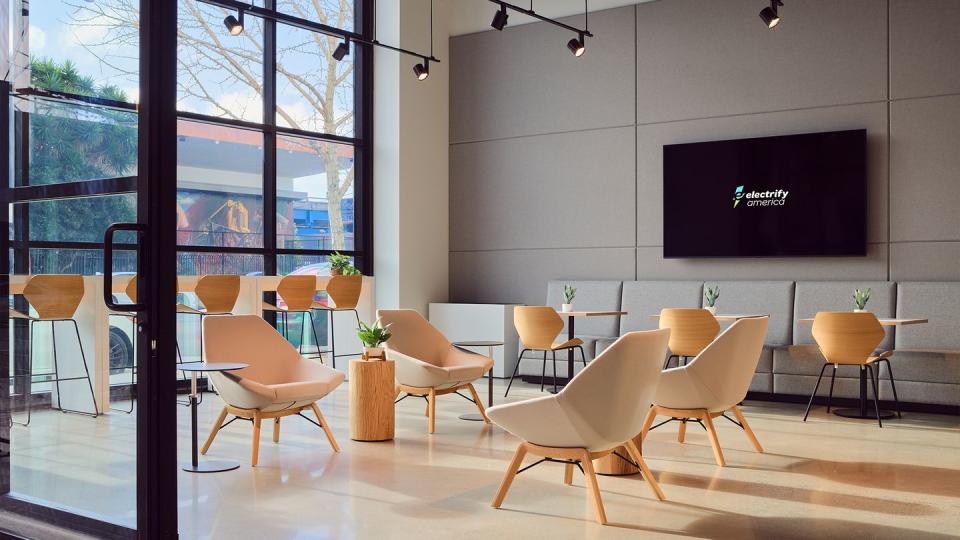This EV Charging Hub with a Lounge, WiFi, and Snacks Is a First

Electrify America opens flagship indoor charging station in San Francisco at 928 Harrison Street, near the Bay Bridge, offering 20 spots with 350-kW chargers.
The station is the first of its kind for EA, and it features a lounge for drivers, vending machines, and an attendant.
Large charging hubs with their own staff, snacks, and restrooms are still exceedingly rare in the US, but have begun to appear on a small scale only in the last few years.
By now many EV enthusiasts are familiar with the luxury charging hub concept, even if they haven't seen one in person. Automakers including Audi, Porsche, and Mercedes-Benz have opened a number of standalone hubs, similar in interior accommodations to airline lounges where drivers can relax, eat, or work.
The concept itself has been well-received in those places where such hubs have been launched, opening the door for an entirely new charging experience.
But the latest hub opened by Electrify America earlier this month is different in one important way: The cars charge indoors. And not in a parking garage of some mall, but inside a standalone structure.
The company's indoor flagship station has opened this month just two blocks away from the Bay Bridge in San Francisco, and it's the first of its kind for Electrify America.
The station features nothing but 350-kW chargers with spots for 20 cars, while also offering a lounge area, round-the-clock security, food and drink vending machines, restrooms, Wi-Fi, and an attendant.
The station builds upon an earlier charging hub concept that EA launched in two other locations in California, but the charging stalls in those stations were outdoors.

"We're committed to making EVs accessible to all, particularly in dense urban areas like San Francisco," said Robert Barrosa, president and CEO of Electrify America.
But there are still a couple of things this station is not. It is not a convenience store with soda machines and hot dogs slowly turning on rollers, or other things that we can find in regular gas stations such as small hardware items, lottery tickets, or phone peripherals.
It is difficult to ignore a couple of other aspects of charging in San Francisco: Security and charger reliability has been a problem, even if weather has not.
San Francisco is certainly not unique among large cities when it comes to these challenges, but these issues have been particularly acute here.
Of course, one other reason we haven't seen many indoor charging hubs like this in the US until now, we suspect, is that it hasn't been economical for station builders or developers to design stations in this manner, as there is only so much money they can charge for electricity going into cars even in cities with a lot of EVs.
The foot traffic has to be there to make this profitable, with millions of dollars in hardware invested, and the pricing for charging has to be vaguely on par with stations that don't offer some of these amenities.
Doing so in San Franscisco, in a city with some of the most expensive land in the country, is certainly rare, even if this particular station is not in the most expensive part of town.
Similarly, if this former bus workshop had been turned into studio apartments, we suspect that could be quite profitable as well. And that's basically what has been happening in San Francisco for the past couple of decades, and there is still plenty of unmet demand for housing.
Developers in the city have evidently decided that, at least at the moment, it's more profitable to build things other than charging stations of this type in San Francisco.
However, we suspect it's only a matter of time before most parking garages in large cities install EV chargers and turn into a version of this sort of station, even if without snacks or other niceties or blazing-fast charging speeds. That's a comforting thought for the future.
Will we see more stations of this type in the coming years, or will stations like these remain relatively rare? Let us know what you think.

 Yahoo Autos
Yahoo Autos 